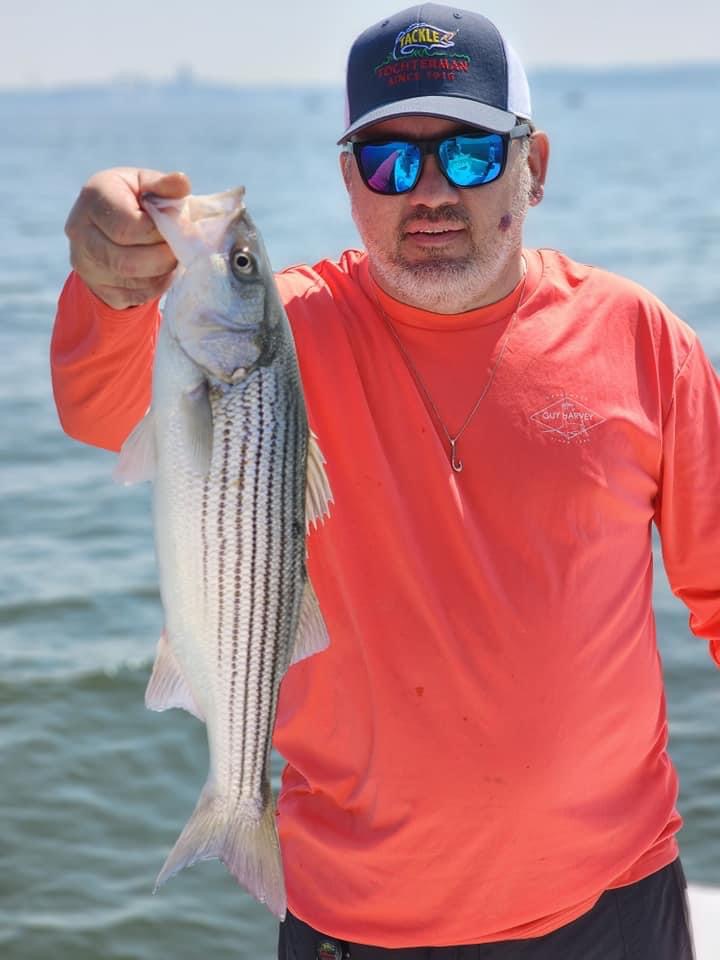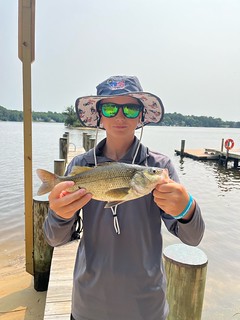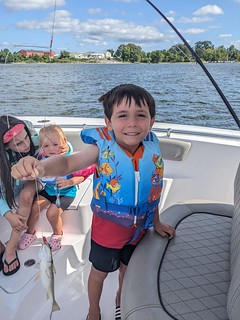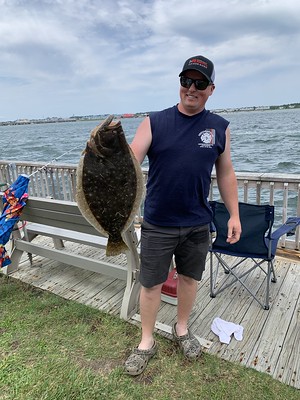Maryland & Chesapeake Bay Fishing Report- August 3, 2023
Bluefish and Spanish mackerel blitz on bay anchovies, anglers live-line spot for striped bass in 30-foot depths, and big red drum take soft plastics in the lower Bay.
Tochterman’s Fishing Tackle Report — Baltimore, MD
The Tochterman’s Fishing Tackle Fishing Report is written by Tochterman’s team member, Kevin Trupia.
Striped bass season opened back up on Tuesday August 1st, with most of the action at the Conowingo Dam. Paddletails, bucktail teasers and topwater lures are working best. Topwater action is still mostly reserved to the early morning and evening.
Blue cats are still in abundance all throughout the bay and its tributaries with cut bait being the best choice for these invasives.
White perch can be caught all over too. In deeper water, a bottom rig tipped with live bait like grass shrimp, bloodworms or lugworms will catch multiple perch at once. Spot can also be found down towards the Bay Bridge and Sandy Point, and some are small enough to use for live-lining in the area.
Snakeheads are also around, and the best method to catch them is casting weedless frogs in the grass to entice a bite while they’re with their fry balls. Also, spinners, weedless flukes and chatterbaits work well when a frog doesn’t do the job.

The Tochterman’s Fishing Tackle Fishing Report is written by Tochterman’s team member, Kevin Trupia.
Maryland DNR Fishing Report
Maryland Fishing Report is written and compiled by Keith Lockwood, fisheries biologist with the Maryland Department of Natural Resources.
Striped bass fishing has resumed in Maryland’s portion of the Chesapeake Bay and its tributaries. The July two-week closure, in place to protect the resource during the hottest part of summer, has ended but the Department of Natural Resources still advises you to take caution when targeting striped bass.
Upper Chesapeake Bay
The 2023 summer-fall striped bass season is open, and anglers will be casting topwater lures and paddletails for striped bass in the Conowingo Dam pool and the lower Susquehanna River. The best fishing will occur during the early morning and late evening hours. The dam is now in its summer power generation schedule so evening anglers need to be aware of increased flows if wading.
Blue catfish remain a focus for anglers in the lower Susquehanna and most of the tidal rivers in the upper Bay. Fishing for white perch is also a major focus for anglers in the tidal rivers and select knolls in the upper Bay. Bottom rigs baited with grass shrimp, pieces of bloodworm, or artificially scented baits are popular. Casting small jigs, spinnerbaits and beetle-spins along shorelines is a fun way to catch white perch during the morning and evening.
Spot are still being found close to Podickory Point, Sandy Point State Park, the shallower west end of the Bay Bridge, the mouth of the Magothy River, and inside the Patapsco River and Curtis Creek. Most are small enough to use in live-lining for striped bass.
The mouth of the Patapsco River would be a good place to start fishing for striped bass by live-lining spot. Striped bass fishing should also be good at the Love Point rocks and the Tolchester Lumps.
Middle Bay
Striped bass anglers picked up right where they left off now that the striped bass season has reopened. One angler reported success catching striped bass off Chesapeake Beach by live-lining spot in 30 feet of water. It will take some exploring to track down where striped bass might be holding. Some good places to start will be the east end of the Bay Bridge, the shipping channel edges, the mouths of the tidal rivers, and near Poplar Island.
Jigging and trolling along the edges of the shipping channel are good tactics this week. Soft plastic jigs are the most popular lure to use when jigging. Trolling umbrella rigs with swimshads or bucktails dressed with curly tails as trailers and small Drone spoons behind No. 1 planers or inline weights can be a good way to fish. The channel edge from Buoy 83 south to the Sharps Island Light is reported to be a good place to find bluefish.
Anglers fishing early mornings and late evenings along the shallow waters in the lower sections of the region’s tidal rivers are finding speckled trout and striped bass. A few slot-size red drum are also being reported by anglers. Casting topwater lures in the form of poppers and Zara Spooks are a popular way to fish, paddletails also make a good choice.
Bluefish are becoming more common in the middle Bay, and Spanish mackerel can be found mixed in with them. If you’re lucky you may see diving gulls marking locations where the bluefish have pushed schools of bay anchovies to the surface. Casting small heavy and shiny metal jigs or Got-cha lures into the breaking fish, allowing it to sink before retrieving is popular.
Fishing for white perch is in full swing and they can be found in many easily accessible locations. Any dock or pier over some decent depth of water usually holds white perch close to the pilings. White perch love structure, so fish straight down with a simple bottom rig baited with grass shrimp.

Lower Bay
Striped bass season is now open again in Maryland waters, although Virginia waters and the main stem of the Potomac River remain closed. Increasing numbers of Spanish mackerel, bluefish, red drum, and cobia are steadily moving into the region.
Striped bass can be found along the shorelines on both sides of the Bay and in the tidal rivers. Casting topwater lures, jerkbaits, and paddletails is a popular way to fish during the early morning and late evening when tides are moving. Structure such as rocks, deepwater piers, bridge piers, stump fields, and grass beds are all good places to target. When fishing over grass beds, placing a popping cork over the paddletail will help keep it above the grass; this is an excellent way to target speckled trout. Red drum within the 18-inch to 27-inch slot limit are being caught this week, mostly on the eastern side of the Bay around Tangier Sound, but they can also be found along the western shore.
Fishing for a mix of white perch, small croaker, and spot could hardly be better in the lower sections of the region’s tidal rivers. The top choice for bait is bloodworms and artificial bloodworm-scented baits. White perch can also be caught in shallow waters during the mornings and evenings on small spinnerbaits, beetle-spins, and jigs.

Bay anchovies are the general target of the bluefish and Spanish mackerel, which are providing good fishing opportunities for anglers along the edges of the shipping channel, Tangier Sound, and other areas. When they push baitfish to the surface the action can be an exciting event to encounter – casting small but heavy and flashy metal jigs or Got-Cha plugs into the fray is a fun way to catch them. Fast retrieves are best for Spanish mackerel, slower for bluefish.
Large red drum are being found mostly in the general area of the Target Ship, the Mud Leads, and the Middle Grounds. Often, they can be found by troubled or discolored water and large marks on a depth finder. Dropping soft crab baits to them or jigging with large soft plastics is a great way to enjoy some exciting catch-and-release action.
Anglers are anxiously waiting for better numbers of cobia to move into the lower Bay. Chumming and sight-fishing are the two most popular ways to fish for them. Many anglers are drifting live eels at the very back of their chum slicks. Those sight fishing are casting large soft plastics and live eels to cobia when they are spotted.
Atlantic Ocean and Coastal Bays
Along the beaches of Assateague Island, surf anglers are enjoying some exciting catch-and-release action with large red drum during the evening hours. Large baits of cut mullet, menhaden, or clams are enticing these large fish. Inshore sharks can also be part of the evening mix. When fishing these species using circle hooks, it is a good idea for fish and angler to flatten the barb.
Anglers using smaller baits of bloodworm – real or artificial – are catching kingfish and spot. Casting Gulp baits or squid strips into the surf can be a good way to catch flounder; northern blowfish are also hitting the squid baits. Cut bait or finger mullet is a good way to catch bluefish in the surf.
At the Ocean City Inlet, sheepshead are being caught on sand fleas near the South Jetty and the bridge piers of the Route 50 Bridge. Bluefish and striped bass are roaming the area and are being caught by casting soft plastic jigs and Got-Cha lures and by drifting cut bait. Outside the inlet and relatively close to shore, Spanish mackerel and bluefish are being caught by anglers trolling Drone and Clark spoons in gold, chrome, and various colors behind No. 1 and No. 2 planers. At the wreck and reef sites fishing for a mix of sea bass and flounder has been very good.

Farther offshore at the 30-fathom lumps and the canyons, anglers who are trolling are finding improving catches of yellowfin tuna, with a few bigeye tuna at times. White marlin are being caught and released and anglers are finding good numbers of small dolphin near lobster pot buoys and flotsam. Deep-drop anglers are catching blueline and golden tilefish.
Maryland Fishing Report is written and compiled by Keith Lockwood, fisheries biologist with the Maryland Department of Natural Resources.
Reel Chesapeake Fishing Report – Annapolis, MD
The Reel Chesapeake Fishing Report is written and compiled by writer and media professional, James Houck. Find the full report here, at reelchesapeake.com.
It’s refreshing and amazing how a regionwide cool down from 90F-plus degree days to high-70s gets folks chirping about the coming fall season. Though we’re still in the dog days of August (just starting really), it certainly hasn’t felt like them. The middle Chesapeake experienced several fronts blow through late last week (a few with high winds and rain). This caused temps to drop, both air and water, and flows to increase in many watersheds. Then a consistently calm start to this week piggybacked those fronts and has made for very pleasant outings. Oh, and striped bass season reopened on August 1st throughout Maryland’s portion of the bay. Everything seems right and good.
Northern snakehead fishing continues to be excellent right now. Sight fishing for them in all their haunts is producing many fish, and big ones! On Sunday, I fished a Little Patuxent River hole and met a couple others doing the same. Their take is that the snakehead have started moving downriver. We didn’t see any at this spot, but did hook into largemouth bass. A few days later, on Wednesday, I visited another Patuxent stretch—indeed, downriver from the last—and spotted a nice specimen swimming south toward me on the far bank. I had just enough time to reach for my frogging rod and launched/landed the topwater lure about five yards ahead of the fish. It started following the plops and then attacked the bait…hooked ’em! What a pleasant and fortuitous encounter with a solid 26-inch specimen. Had I hit a stop light en route to this spot, I would have missed this fish lazily swimming by. But I digress.

Search for snakehead in slow-moving and standstill water, especially thick with cover, at any accessible honey hole along the Patuxent from Bowie south. Jug Bay could be especially juicy right now. Many snakehead are protecting fry—possibly from a second spawn even—and can be enticed with topwater creature baits, buzzbaits, chatters, and inline spinners. The creeks of the Potomac, the upper Bay rivers, and Blackwater on the east side—any rivershed with grass and/or pad abundance—will be holding snakehead.
Bluefish and Spanish mackerel continue to be the talk of the middle bay, as anglers eagerly await their arrival. Bluefish have been caught from the Bay Bridge south and, just this week, we’ve heard the first reports of mack encounters in the Poplar Island vicinity (one angler claimed eight hookups!). They should push across to Thomas and Tolley Points within a couple days and maybe even reach as far north as Hacketts Bar and the bridge (even further?). Try trolling #1 or #2 planers with mid-sized Drone, Clark, or Tony spoons at about 5 to 7 m.p.h. to get strikes. If you find a feeding school, try casting G-Eye rain minnows, 1/2-ounce Kastmasters, or other metals ahead of the frenzy and retrieve through it as fast as you can reel.
Tuesday marked the opening of “fall” striper season, which continues through December 10th, during which recreational anglers may keep one 19- to 31-inch slot fish per person per day (two if fishing on a charter vessel). Those who’ve jumped at them are having success at sunrise and sunset with topwater plugs like Smack-It Juniors, big spooks, or MirrOlure Popa Dogs, or flycasting large Deceivers and similar streamers. The Key Bridge in the Patapsco, shorelines off Eastern Bay, and Poplar Island’s riprap further south are the primary targets of the charter fleets. If you want consistent schoolie action in the 17- to 21-inch class, head into the mid-bay rivers (Magothy, Severn, South, West/Rhode, Chester, Choptank) and try similar tactics at similar hours at any sandbar, stretch of riprap, or grass flat. The amount of baitfish in the rivers and their creeks continues to be shockingly abundant. And stripers are feeding well at low light. The feeding windows will continue to widen as fall approaches.
For midday fishing, hit the deepest-water docks you can find, shaded shorelines with deep drops, and deep channel structure. Deep is the name of the game, where stripers will hold but can be enticed with classic jigging techniques (I love 3/8- to 1/2-ounce bucktails or jig/paddletail combos). Live liners are also active throughout the Bay, catching spot to fill the livewell before dropping the baitfish into the middle of marked schools or around bridge pilings—the Bay Bridge and drops on either side of the shipping channel are where many anglers begin their day trying this technique.
White perch have been tough to find for those searching throughout the main Bay, and here’s why. The fish are still loaded in the rivers and creeks—they’re still stacked upriver, so to speak, with all the baitfish. It’s that simple. We continue to slam the perch in the Round Bay vicinity of the Severn River, for example. Again, aim for structure and shade with small offerings. Quarter-ounce spinnerbaits, 1/4-ounce Kastmasters, 1/8-ounce jigs/micropaddles, and 1/16-ounce stingers will produce hits. Of course, grass shrimp or pieces of bloodworm lowered down on a small #6 hook is surefire.
Another interesting development has been an increase in puppy drum (only up to 17 inches or so) being caught within these same mid-bay rivers, and as far north as the Magothy. Several anglers have boasted these rather rare catches on social media this week. The big bulls are still south, however, and will continue to feed in the shallows of Tangier onward to the bay’s mouth and the Atlantic beyond. Cutlass fish have also been consistently in the mix, especially in the Point Lookout vicinity. The cobia run into the bay hasn’t seemed to push as far north as hoped, with most reports still coming from the Virginia line south.
And crabbing…what can we say? It’s hit or miss and dependent on beating others to the potential hotspots in the wee hours of the morning just in time for sunrise. Bushel catches are possible for trot liners in most of the rivers. Folks report depths under 10 feet—with most reporting 5 to 7 feet—are where the crabs are sitting. We tried chicken necking off a pier last weekend and caught less than a dozen. Just got to keep trying. Good luck!
View the full Reel Chesapeake Fishing Report, written and compiled by writer and media professional James Houck, at reelchesapeake.com.
Leave a Reply